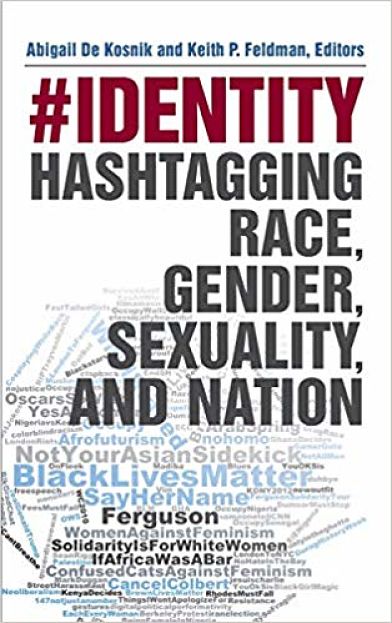#Identity: Hashtagging Race, Gender, Sexuality, and Nation by Abigail de Kosnik and Keith Feldman (eds) serves as an exciting reminder of the illuminating potential of academic inquiry. An edited collection of work from the UC Berkeley-based Color of New Media Working Group, the essays of this book analyse “how people of colour, female, and queer people, and people outside the United States have navigated and developed digital networked spaces.” Building on established New Media scholarship that challenges the presumed whiteness of social media, the essays in this book reveal and analyse the inherent diversity of experience present in our social media landscape from a critical theory perspective. Conceived in response to theatre director Ashley Smiley’s contestation to “dwell for a moment on ‘the hashtags you’ve been forced to remember’” this book serves as a pathway to critically digest through an intersectional perspective the information patterns of our over-saturated daily lives.
In its introductory section, the book starts out with a helpful piece by de Kosnik that conceptually frames what follows. Positing whether twitter is a stage, de Kosnik applies two performance theories to the social media space. First, she uses Irving Goffman’s The Presentation of Self in Everyday Life in order to “conceptuali[ze] digital networks as performance”, which thus “emphasizes the individual’s experience of those networks.” Then, de Kosnik applies Marshall McLuhan’s concept of the “global theatre” in order to develop an “approach to digital networks as performance spaces” in which “more attention [is] to be paid to performances by collectives. “These two complementary analytical frameworks, of individual and collective performances on social media, lay the groundwork of analysis for the remaining parts of the book.
The b
The second part, on “Mediated Intersections”, interrogates the political implications of hashtag activism. Presented as a deep dive “into the intersections between digited networked communication and various groups,” the inclusive chapters all examine how social media participation builds community and has political impact. The chapters focus on the organizing of feminists and postfeminists, survivors of relationship violence, queer, Latinx, and queer Latinx people.
Importantly, the scholars of this section note that community building and political impact are not necessarily positive phenomena, as Ogle’s article observes that the self-identified feminist and parodic #ConfusedCatsAgainstFeminism blog reinforced antifeminist claims in postfeminist narratives.
In this section are insightful terms that define common phenomena, such as Lizárraga and Cortez’s description of “queer residue”, as a way to describe the queer Latinx experiences at risk of erasure by gentrification in San Francisco as archived on the social media accounts of the drag queen Persia.
Part III, on “Disavowals” focuses on “the reactionary deployment and effects of social media intent on securing white and heteronormative forms of identity.” The three papers that make up this Part are the strongest of the book because of how the writers critically analyze dynamics on social media to reveal the underlying logics of broader societal trends beyond the internet.
In this section, the authors challenge prominent narratives behind popular hashtags. Booten’s piece reveals that while #alllivesmatter has become part of the rhetoric of anti-blackness used to respond to the #blacklivesmatter movement, its uses online defy such clear cleavages with some #alllivesmatter users advocating a civil rights agenda.
While Ruberg’s piece on the uses of #nohomo on twitter reveal how cisgender heteronormative men use this hashtag not to perpetuate homophobic ideals, but to performatively overcome their gender anxiety and assert their heterosexual masculinity. Lastly, de Kosnik’s piece brilliantly investigates the controversy of the #cancelcolbert hashtag to discover how the cultural progress of the 2010s has produced the rise of the ‘divo citizen’. Building off Berlant’s theory of the ‘diva citizen’, de Kosnik argues that alt-right netizens have reconceptualized themselves as threatened minorities of ‘PC culture’ that voice their racist, homophobic diatribes as acts of resistance against their “strong feelings of subordination.”
The fourth part, “Twitter International”, looks at the power and potential of new media across the world. The essays in this chapter reflect on the use (or non-use) of twitter by lower-middle income youth in India, the dynamics of different trending hashtags in Nigeria and Ghana, the pan-African twitter conversation of #IfAfricawasabar, and the discursive activism—both online and offline—of black Britons. This collection of essays is more empirical in its focus on the global variation in new media engagement around the world. They are followed by Part V, “Notes from the Color of New Media”, which are edited transcriptions of two meetings from the Color of New Media Working Group after the inauguration of Trump and in the run up to Berkeley Free Speech Week. These transcriptions were a clever ending to the book because the commentary from the Working Group members, often rooted in their own experience, once again grounds in reality the esoteric themes discussed in the book. Additionally, it reminds the reader of the weight that this Working Group and book is published by scholars of UC Berkeley, an academic institution that has always been at the vanguard of radical political and intellectual engagement—and with this book continues to be so.
As a whole, #Identity provides a range of frameworks through which we can interpret and understand, through an intersectional lens, the oft-times overwhelming cacophony of social media.
The book’s mix of high theory and empirical examples allows it to be of interest to both scholars working on topics of identity and activists fighting for a more inclusive world. The power of this work is in how it takes seemingly mundane or isolated experiences of everyday life on social media and connect them with broader global power dynamics that can empower or disenfranchise. Through critically reflecting on online communication spaces, the scholars make sense of how mass communication become the avenue for revolution.
As with any edited collections, the overall coherence of the text suffers from having multiple authors. While the range in epistemological approaches to uncovering truth can be interesting, some texts feel uneven— whether too short, too empirical in comparison to other chapters, or too much of an experimental poster structure. While this variation does allow for a bit of rest between denser chapters, I think a more cogent structure of each chapter would have allowed the reader to absorb some of the broader themes of the book, as opposed to taking disparate messages from each chapter. Additionally, with some of these empirical chapters, the analysis feels a bit prescriptive: analyse an empirical phenomenon, find a matching theory, discuss results. This formulaic approach in a text rife with high theory and analytical heft emphasizes the descriptive nature of these chapters which at times seem more fit for a specialized journal than this book. With that said, on their own, these descriptive chapters are interesting to read and produce interesting insights.
Another missed opportunity of this text is in its framing. Based on conversations and work between 2013-2015, the book predominately reflects on the nature of social media before “the alt-right took over twitter” (Singal 2017, quoted on page 9) in 2015. As such, when reading about the different power dynamics present in social media performance, weighing in the back of the reader’s head is the world we live in today, whether these dynamics still persist when social media has been hijacked by demagogues with legions of anonymous trolls. Certain texts feel almost dated because the dynamics they cover refer to a recent past.
This alleged missed opportunity, though, could be rewritten as simply this reader wanting more. The book presents a new ambitious research agenda to continue to interrogate how the diversity of the world creates a prism of experiences on the internet. The range of new voices presented by this work is exciting in that it demonstrates the high quality, considerate work of the future of the academy. In 2020, with the primacy and durability of social media established, we need more research such as that present in #Identity to make sense of the vulnerabilities and opportunities created by the ever-shifting new media landscape.
Featured image (cropped) by anokarina (flickr, CC BY-SA 2.0)









